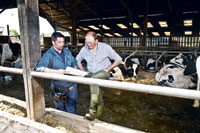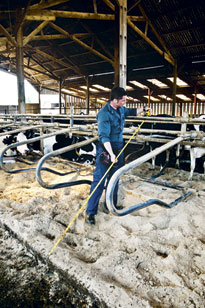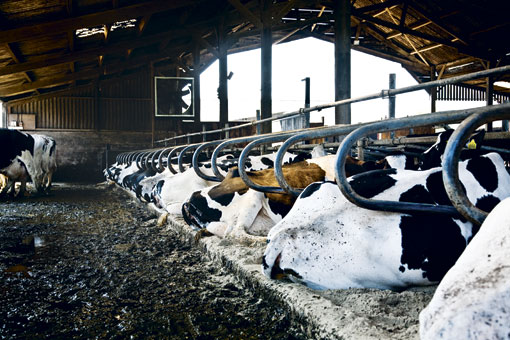Better building design can improve cow welfare

Low-cost changes to building design can significantly improve mastitis and lameness incidence, Aly Balsom reports
With consumers placing more and more emphasis on animal welfare, it is only a matter of time before milk price is attached to cow comfort and welfare.
And with this in mind, two years ago, Kent dairy farmer, John Downing took the step to quantify and improve cow comfort in his herd of 320 pedigree Holsteins, by undertaking a How’s My Herd assessment.
“As a Marks & Spencer producer, our milk price is going to be affected by cow welfare score from October this year,” explains Mr Downing. “But although our buyer may be ahead of some processors, there is no doubt other companies will follow suit.”
And by independently assessing cow welfare at farm level, producers can be prepared for any changes in price reward.
How’s My Herd is a complete on-farm assessment that aims to identify the main pressure points affecting production on farm, explains Kingshay consultant and Farmers Weekly Livestock Adviser of the Year 2009, Rob Mintern.
The assessment starts with a one-day visit looking at parlour routine, cow behaviour, building layout, ration and herd health. Findings are then collated into a farm specific report, using a traffic-light system to identify key areas for attention.
“The assessment is completely measurable and evidence based, but the report is designed so findings are as practical as possible,” explains Mr Mintern.
 |
|---|
| Rob Mintern helped identify the main pressure points on John Downing’s dairy farm. |
Investing in improving and maintaining cow comfort has always been the aim at Wintershall Farm, Edenbridge, but by having an independent, fresh pair of eyes on farm, Mr Downing has been able to make significant improvements.
“I have spent many years trying to get cow comfort right, but we have achieved far more with Rob than we have in the many years before.”
Mr Downing has made several changes as a result of the How’s My Herd two years ago, and consequently, a follow up report this year has highlighted significant improvements in foot health and mastitis, says Mr Mintern.
Mastitis
“The initial How’s My Herd identified ventilation as one of the key influencers to mastitis. At the time, the farm was experiencing problems with fresh calvers housed on a loose straw yard adjacent to the collecting yard.”
The central ridge between the two areas was capped, preventing air from flowing out of the building. As a result, water produced by respiring cows in the collecting area was unable to escape, creating damp beds and an ideal environment for mastitis-causing bugs.
The central ridge has since been opened and the wall onto the collecting yard partly knocked down. At the time, mastitic, fresh and sick cows were also mixed, but now mastitic cows are housed in separate cubicles and milked after the main herd.
Air flow has also been improved in the main heifer and dry cow shed on the other side of the straw yard by removing a partitioning wall and every third Yorkshire board. Most of a hay loft in the main shed has also been taken out to encourage air to move out through the open ridge.
“These improvements have served to dramatically reduce the total number of mastitis cases to such an extent that the number of cows identified as “under heavy stress” from mastitis (red on the traffic-light system) has been reduced to zero,” says Mr Mintern.
“A reduction in mastitis incidence has been due to a number of alterations, including changes to ventilation, sand type, cubicle size and foot cleanliness, which have all resulted in happier, healthier cows.”
Lying Times
Following preliminary animal behaviour observations, cow lying times have also been addressed.
“At the time of the initial assessment, only 49% of cows were lying at one time and that should be more like 80%. About 8% of cows were also perching two feet in and two feet out of the cubicles, when there shouldn’t be any.”
 |
|---|
Maximising lying times can improve yields and help reduce lameness. |
Maximising lying times will improve yields and reduce lameness, explains Mr Mintern. “When animals are lying, 30% more blood goes to the udder, equating to an increase in milk production of at least one litre an hour.”
Rest time is also important “repair time” for mastitis or lameness, he says. “Lying animals will use less energy than when they are standing, producing less heat and improving comfort.”
Following Mr Mintern’s recommendation to improve cubicle dimensions, Mr Downing worked with a local builder to create an array of adjustable brackets that work on the existing loops. The cubicle neck rails have since been lifted to 1.3m above the bed, to achieve a diagonal distance between the rail and curb stone of 2.2m.
“These measurements are specific to Mr Downing’s herd and will vary depending on cow size,” stresses Mr Mintern.
In some beds, the brisket board has also been moved forward to stop cows from hanging out the back of the beds when lying and a concrete wall knocked out where possible to provide lunging space.
“Since these changes have been made, lying times have improved dramatically. Two hours after milking, 100% of heifers were lying perfectly in the cubicles,” he says.
Lameness
Improving cubicle dimensions and foot-bathing routines have also resulted in a marked improvement in lameness, explains Mr Mintern.
“Digital dermatitis and sole ulcers were the main causes of lameness in the herd during the first assessment.”
Initially, cows were being foot bathed once a week through two plastic baths on the parlour exit. However, this was causing issues with cow flow and bath contamination.
“Cows habitually muck as they leave the parlour, so treatment baths were becoming soiled and ineffective after a few cows,” he says.
A race near the parlour has since been modified to include a wash bath at the start of the race, followed by 20m of concrete leading to a treatment bath. An existing water pipe has also been used to siphon roof water into the trough.
Cows now go through the system every day, says Mr Downing. “Because there is a gap between wash and treatment bath, after 300 cows the treatment bath is still clean.
Incidence has now dropped significantly because of better foot bathing, trimming and reduced standing times, says Mr Mintern. Now, 76% of cows have no lameness problems whatsoever (mobility score zero).
Farm specific report
“Overall, the recommended changes have been relatively inexpensive to make,” says Mr Downing.
It is possible to make significant improvements to cow comfort, by making low-cost changes to existing buildings, explains Mr Mintern.
“And because the report lists key areas for attention and places actual financial costs alongside specific problems, it is possible to prioritise specific areas and change accordingly.”
One of the main attractions of the How’s My Herd report is the fact it is farm specific, stresses Mr Downing. “The report is illustrated with photographs taken from your unit, meaning the evidence is right in front of you.
“The cost of the report is also relatively inexpensive considering the huge payback you can receive as a result of the changes made.”
